The Dead Sea - a small lake located at the lowest point on the face of the earth - is a true natural wonder. It offers travelers pure white crystal formations, sulphuric mud, and water so salty you can float on it while reading the paper.
You can visit the Dead Sea from Jordan or Israel. We've visited it many times on the Israeli side, so today, I am sharing a concise guide to visiting the Dead Sea in Israel.
(This post was originally posted in 2016, but I've revised it and added a lot of new information, so I'm re-publishing it.)
The Dead Sea is an inland body of water that is located between Israel, the West Bank, and Jordan along the Jordan River Valley. It is so-called because the high mineral content in the water allows almost nothing to live within it.
This place is truly a top-league curiosity of nature. Standing there deep inside the deep Jordan Valley, next to the super salty water, brings up many questions about the place.
I will try to provide some answers about this natural wonder further down the post once we get past the practical aspects of visiting the Dead Sea.
I'm going to assume that you're reading this post because you are planning a trip to the Dead Sea. Maybe you're already in Israel and need quick tips about getting to the place and how to spend your time there.
Or maybe you're still researching for a future trip to the Holy Land. Either way, I will try to help you by explaining how to visit the Dead Sea, what to do when there, and also - and this one is important! - how to visit it safely.
Once we sort these things out, don't forget to keep reading so you can get to the little Dead Sea FAQ I prepared with information about how the place was formed (and a few other tidbits). Oh, and photos! Tons of beautiful photos of the Dead Sea - just in case you're not sure if you should visit or not 😉
How to get to the Dead Sea in Israel
Where is the Dead Sea?
The Dead Sea is not really a sea. Rather, it's a (very!) salty lake east of Jerusalem. The border between Jordan and Israel goes through the middle of the lake, running from north to south. There's another border of sorts on the Israeli side: the one between Israel and the Palestinian Authority.
Without getting into the politics of the matter, it bears keeping in mind that the northern part of the Dead Sea is, in fact in Palestinian territory that's under Israeli military control. I colored the areas in this map to show how the Dead Sea is divided. The Jordanian areas are covered in red, the Palestinian in green, and the Israeli in blue -
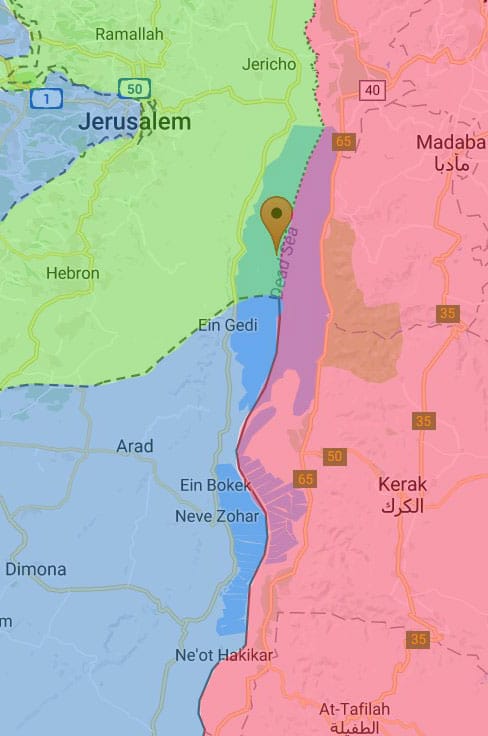
I know nothing about visiting the Dead Sea from the Jordanian side. I mean, I do know it's possible, but I can't help you with too much information about that. While there is no state of war between Jordan and Israel, for various reasons, people from these two countries seldom visit each other.
Sad, but true. A vehicle with Jordanian plates is a rare site in Israel, and I'm sure the same is true and vice versa.
I'm mentioning this to let you know that if you happen to be visiting both countries during your trip, you'll be able to visit the Dead Sea from both shores. This guide focuses on visiting the Israel side.
Visiting the Dead Sea from Jerusalem
The Dead Sea is approximately 30 miles or 50 kilometers away from Jerusalem. Driving the distance, you'll be going from an elevation of approximately 2400 feet (740 meters) to -1,410 (or -400 meters).
Yes, that number is negative - you are going to the lowest point in the world! My point is that it's pretty much a steep descent, which means switchbacks and slow driving during parts of the way. Also, much of the way goes through the urban suburbs of Jerusalem.
The bottom line is that it's not as short a drive as expected. Assuming you're not leaving during rush hour, it should be about an hour to reach the northern edge of the Dead Sea.
Taking the bus
Taking the bus from Jerusalem won't be much slower than driving in this case, so it's a good option. Bus route 468 will take you from the Central Bus Station in Jerusalem to Kalya Beach on the northern tip of the Dead Sea in about an hour and a half.
It will take longer if you want to get to the beaches in the Ein Bokek area (the southern end of the sea). It's only an extra 20-30 minutes by car. The bus will take about an hour longer to get to that area because it stops along the way. It's a beautiful drive either way.
Just keep in mind that if you want to get the full experience and spend time in the southern end of the sea, staying over for the night may be a good idea. I'll discuss where to stay further in this post.
Visiting the Dead Sea from Tel Aviv
There are two ways to reach the Dead Sea from the Tel Aviv area. I'm mentioning that city because -
- It's one of the largest cities in Israel.
- That's the area of the country's main airport.
- It's where you should spend a day or two for all the awesome things to do in Tel Aviv!
So, you can take one of two routes when visiting the Dead Sea by car from the Tel Aviv area. The first goes through Jerusalem and the Palestinian area.
Driving is safe, but you will go through at least one military checkpoint. The other route goes south of Palestinian territories, bypassing the green areas on the map through the town of Arad.
Both roads are perfectly safe for you to go through if driving a car. Follow the shortest bus route if you're visiting the Dead Sea using public transport. It almost always means getting to Jerusalem and taking a bus from there.
If you intend to visit the Dead Sea on a day trip using public transportation, do that from Jerusalem. From Tel Aviv, the entire trip will take you about two hours if you drive your own car and 3-4 hours if you're taking a bus.
That's each way. The bus option takes long enough to justify at least one-night stayover in the area. Either that or take your day trip from Jerusalem.
Organized tours to the Dead Sea
These are always an option. If you Google the "Dead Sea tours," you'll find many options from Jerusalem or Tel Aviv. These tours are what they are. They will get you to the place and save you a lot of the hassle. Some may offer a guided tour that will possibly add to the experience.
The cons are those of organized tours everywhere else on the globe. You pay more, and you have less flexibility. And there will probably be a tour of at least one gift shop...
How and where can you get to the water?
When visiting the Dead Sea, bathing in the super salty water is a must-do. There are several beaches along the Israeli coastline of the Dead Sea where you can park your car and walk down to the water.
In the northern part of the Dead Sea, you'll find Kalia Beach & Biankini Beach right next to each other. Both have swimming pools, showers, bars and restaurants.
In the southern part, the Ein Bokek beaches and the recently renovated promenade that connects them. Most of these are public, so they are free to use. There is a parking fee of 5 shekels per hour (or 25 for the entire day).
The locals know this area as "the hotels zone." If you're looking for a mud spa experience, you can find it in the hotels - most of which run their own small beaches.
The Ein Bokek beaches have everything you need, including lifeguard services, showers, restrooms, and a strip of sand with boardwalks going right into the water.
There are restaurants nearby, including a local McDonalds. I wouldn't recommend their chain normally, but if you want to say you had your Big Mac at the lowest place on earth, there's your chance 😉
When is the best time to visit the Dead Sea?
To help you plan your visit more effectively, we've compiled a detailed table with climate data specific to the Dead Sea region. This table includes information on average temperatures, rainfall, and other relevant weather patterns throughout the year.
By reviewing this data, you can get a clearer picture of what to expect during different months and choose the best time for your trip based on your personal preferences and comfort.
The table is designed to give you a comprehensive overview of the seasonal variations in the Dead Sea area. Whether you're looking to avoid summer's extreme heat or seek the most temperate times for outdoor activities, this table will be an invaluable resource in your planning process.
Please find the detailed climate table below:
| Month | Average High (Celsius/Fahrenheit) | Average Low (Celsius/Fahrenheit) |
| January | 21°C / 70°F | 13.5°C / 56°F |
| February | 22.5°C / 72.5°F | 18°C / 64.5°F |
| March | 26°C / 79°F | 18°C / 64.5°F |
| April | 30°C / 86°F | 21.5°C / 71°F |
| May | 35°C / 95°F | 25.5°C / 78°F |
| June | 38°C / 100.5°F | 28.5°C / 83°F |
| July | 41°C / 106°F | 30.5°C / 87°F |
| August | 40°C / 104°F | 31°C / 88°F |
| September | 37°C / 99°F | 29°C / 84°F |
| October | 33°C / 91.5°F | 26°C / 79°F |
| November | 27°C / 80.5°F | 20°C / 68°F |
| December | 22°C / 71.5°F | 15°C / 59°F |
See what I mean by "very hot"? If you're visiting the Dead Sea during July, expect it to be extremely hot. Over 105°F hot at noon on some days, and not much cooler on others. I prefer not to soak in salty water in these temperatures or even cover myself with black mud.
The water is warm enough to swim in throughout the year. In fact, in August, the average water temperature in the Dead Sea reaches 33.5°C or 92°F which may feel too warm (especially considering it's 105 outside!) In the coldest month of the year - February - the water only gets as cold as 20°C / 70°F which most people consider nice enough to get into the water.
So, what's the ideal time for visiting the Dead Sea and floating in the salty water?
My vote goes for springtime and late autumn -
- March-April
The outside temperature is warm, 25-30° Celsius or 70-80's if you're using Fahrenheit. If you avoid sun exposure during mid-day, you'll enjoy being outside and exploring the beaches. Water temperature will be in the 70s (around 23 degrees Celsius), so you can always cool off in the sea. - November-December
With daytime temperatures in the 70s, you can enjoy hiking in the Judean desert or exploring the beaches. The water temperature is a sweet 80°F during November and only gets a few degrees lower in December. Perfection.
They're not super busy either. We were there a couple of months ago - in February. It was a beautiful, warm winter day, and people went into the water.
Where to stay while visiting the Dead Sea?
The Dead Sea is only an hour away from Jerusalem by car, making it a great destination for a day trip while staying at the ancient capital of Israel.
The sun, sea, and mud are known for their medicinal properties, so many people stay closer to the Dead Sea for several days to treat skin problems like psoriasis. Fortunately, you can stay in many places, including campgrounds, B&Bs, hostels, and hotels.
The following paragraphs include affiliate links to Booking.com, where I make hotel reservations. If you book through these links, I get a small commission without it costing you anything extra, so thank you in advance!
Kibbutz Ein Gedi Hotel - This beautiful kibbutz is right by the Ein Gedi Nature Reserve. Combine hiking in the gorgeous Wadi David or Wadi Arugot (more on that further down this post) with a visit to the Kibbutz's private beach on the Dead Sea (entrance fee to the beach is included in the price of your stay).
Ein Gedi Hostel is a great find for those on a budget. Clean, air-conditioned rooms with WiFi near the nature reserve and the beach. Book your rooms in advance because they are very popular with locals and travelers.
Metsoke Dragot Hostel - Another value option for the budget traveler. Here, you can book a single bed/mattress in a large tent and still enjoy the facilities of the compound and the amazing views. The hostel is a few miles away from the beaches, so if you're relying on public transportation, this may not be a good option.
If you want to stay closer to the public beaches of Ein Bokek, you'll find a great choice of hotels. Isrotel Ganim Hotel Dead Sea offers all the amenities of a big hotel, a pampering spa, and a great location only a two-minute walk from the beach. Another popular choice is Royal Hotel Dead Sea with its indoor pools of Dead Sea water. Click here to see more options by Booking.com in the Ein Bokek area.
Just south of Ein Bokek, you will find the lowest settlement in the world: Neve Zohar. There are several accommodation options in Neve Zohar, some surprisingly affordable. Check out the Dead Sea Zimmer, a small guesthouse with clean, air-conditioned rooms and free WiFi at affordable rates.
Safety Issues - know before you dive in!
The Dead Sea can look very peaceful and inviting. Everyone knows you can easily float in the Dead Sea, so surely you won't ever drown in there, right?
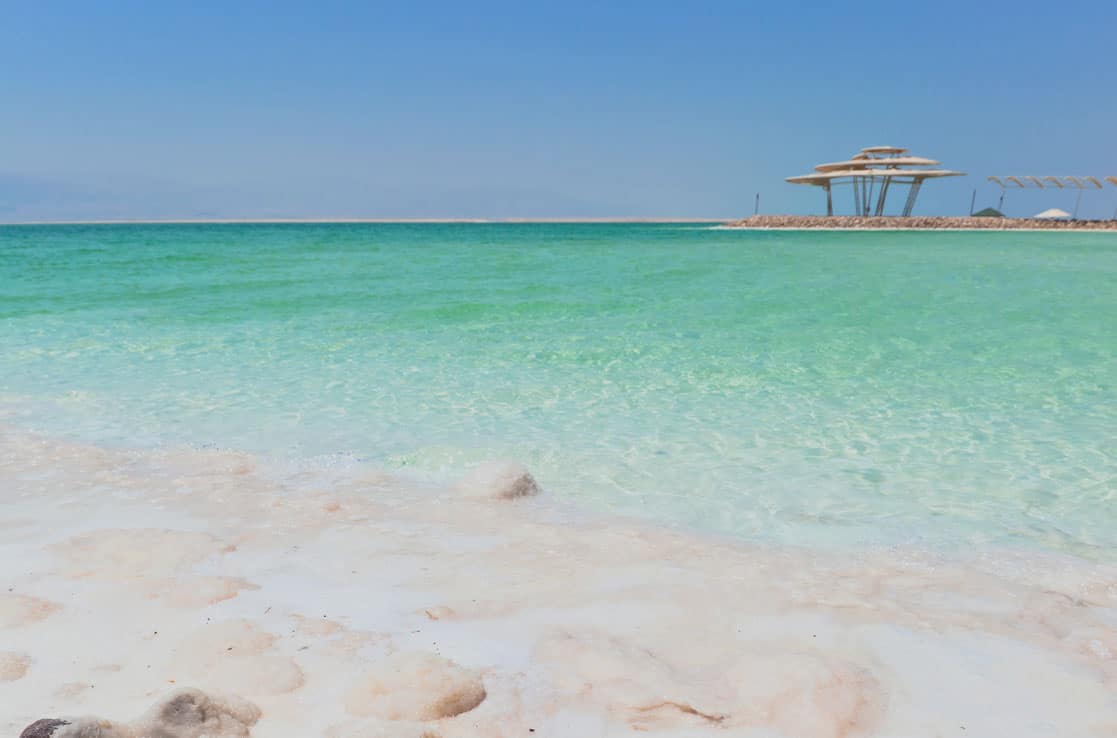
Quite the opposite. More people drown at the Dead Sea than in any other body of water in Israel. The Dead Sea can easily become a real death trap. Here's why:
The water is salty. Extremely salty. Regular seawater contains approximately 3.5% salt. The water of the Dead Sea contains contains 33.7% salt. It's almost ten times saltier than the ocean.
A healthy human skin can handle this salinity level, but you're in trouble if you swallow only a few spoonfuls of water or inhale just a few drops. This is especially true for older people or those with a heart condition.
According to Magen David Adom - the Israeli medical emergency services - most people who drown in the Dead Sea stumble in the water. They fall and get their head underwater for a few seconds, either swallowing or breathing in some of the salty solution. That is enough to require emergency medical care. Technically speaking, they have drowned in the Dead Sea.
Safety guidelines for visiting the Dead Sea -
- Always keep your head out of the water.
- Never go into the water where there is no lifeguard on duty. All of the official beaches have them.
- You may see no waves, but the winds can easily carry you away from the beach. Follow the lifeguard's instructions and stay out of the water if it's windy.
- Walk slowly and carefully. Don't run into the water.
- Whatever you do, do not jump into the Dead Sea!
- No splashing around.
- No alcohol before or during your swim. This place is dangerous, and you need to keep your senses sharp.
- Be careful when getting up if you decide to float on your back. Flipping over on your stomach can be risky. If it happens, don't panic and regain your footing without getting your head under the water.
- If you get water in your eyes, try not to touch them with your hands. Stay calm and ask for assistance. Have someone lead you out of the water and towards the nearest showers where you can wash your eyes with fresh water.
- Be prepared for some pain. Any scratch will hurt. A lot. That's not dangerous but unpleasant (tip: don't shave your legs before bathing in the Dead Sea!)
- Thoroughly wash the salt off your body when you get out of the water.
If you're with kids, make sure they know the rules and can stay calm if water gets into their eyes.
If you need emergency medical help anywhere in Israel, call 101 from any phone.
Other than that, have fun! Visiting the Dead Sea is a unique experience, so make the most of it. The water of the Dead Sea is like nothing you'll ever experience. It doesn't even feel like water! For some reason, all of that salt makes the water feel oily.
Bathing in the Dead Sea is certainly a Bucket List experience, so make sure someone takes your photo as you're floating -
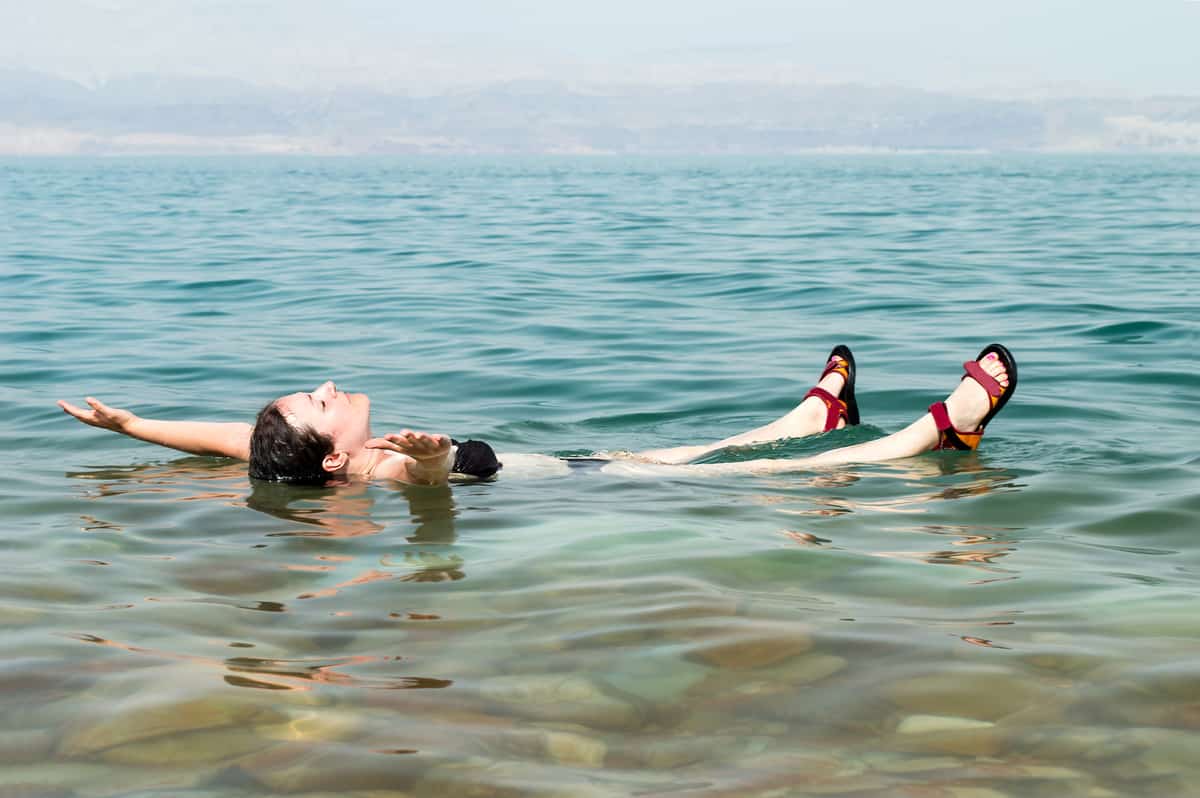
What else is there to see around the Dead Sea?
The most important places to visit around the Dead Sea area are:
- Massada
- Ein Gedi Nature Reserve
- Qumran National Park
Each of these places deserves a post in its own right. And they're not the only things to see around the Dead Sea. This is where the mountains of the Judean desert slope down dramatically into the rift of the Jordan River.
It's the biblical home of Sodom and Gomorrah. The place is rich in beauty and history, and you could easily spend 2-3 days or more exploring everything.
To ensure you won't miss out on the important stuff, here are descriptions of the three places I mentioned. If you can spend a few days visiting the Dead Sea area and getting to all three, you won't regret it.
Massada
I bet you've heard of this one already. It's one of the most popular attractions in Israel that tourists - especially Jewish tourists - flock to. This is the ancient fortress where the people of Judea fought against the Romans in the first century.
Well, "fought against" is probably not the right term. A local extremist group rebelled against the Roman occupation. The Roman Empire didn't like rebellions and tended to squash them quite methodically, as they did here.
When the rebels realized they had no way of winning or even holding off the Romans forever, they decided to kill themselves rather than be enslaved. Thousands of people - men, women, and children - drew lots to be killed by one another, with the last one committing suicide. Two women and five children managed to hide and survive this self-inflicted massacre.
Crazy story. It was well documented in writings from that period, making it a special place for archaeologists and historians to discover and excavate. As a visitor, you can ride up to the fortress in a cable car or hike up or down to the fortress. Going to Masada to view the sunrise over the Dead Sea is a classic hike.
How to see Masada when visiting the Dead Sea
There are two ways to get to Madasa: an eastern and a western access. The eastern gate is connected by road to the Dead Sea. It's a very short drive from the beaches to Masada in that direction.
Here's a link to the official site of the Masada National Park (in English). Check it out for all the practical details of visiting this special place.
Ein Gedi Nature Reserve
A beautiful oasis in the Judean desert, this place is worth at least half a day to visit properly. First, the nature reserve itself. Imagine streams of clear water flowing through the desert mountains with lovely trees and greenery along your hike. You're likely to see ibexes along the way, too.
There are two great hikes in the reserve. They're short and will take 1-2 hours each, depending on your fitness level.
While in the area, you may want to visit the Ein Gedi kibbutz. They have a lovely botanical garden that's worth seeing.
Find out more about the Ein Gedi reserve here. I can't find an official website for the botanical garden there, but I wrote to them to ask if they have one.
Either way, it's open daily and is located in the kibbutz. And don't forget you can stay in the kibbutz too. A great experience, and it's good to be right next to where you're hiking and spending time.
Qumran National Park
Another archeological gem - no shortage of those in Israel - this place is where they found the famous Dead Sea scrolls. You can visit the archeological site that dates back to the 2nd century BC and see the display of artifacts excavated on the site. Of course, the scrolls are displayed in the Israel Museum in Jerusalem.
Located at the northern tip of the Dead Sea, this is a very interesting place to visit if you have a few days in the area. Check out the official park site for more information.
The Dead Sea FAQ
As promised, a few trivia tidbits about the Dead Sea.
Does anything live in the Dead Sea?
For most of human history, people assumed that no life, either plant or animal, could survive in the Dead Sea because of its high mineral content. However, Bacteria have existed in the sea’s waters since the 1930s.
In 2011, according to Scientific American, a team of divers found several hot springs 100 feet below the surface of the Dead Sea. They found biofilms, slimy layers of bacteria adhering to the springs’ rocks, green biofilms on top that feed on sunlight and sulfide, and white biofilms that feed just on sulfide.
Interestingly, the bacteria that make up the biofilms have adapted to cope with the sudden shifts in the water’s salinity as the currents shift.
What created the Dead Sea?
According to Encyclopedia Britannica, the Dead Sea was formed millions of years ago when the Arabian Tectonic Plate collided with the Eurasia Tectonic Plate, creating the landmass comprising modern Israel, the West Bank, and Jordan.
The sea was created in the fracture between the two plates. At one time, the Dead Sea was a vast inland body of water that ran 200 miles from the Hula Valley in the north to 40 miles south of its present southern limits. The Dead Sea is isolated from the Gulf of Aqaba by a 100-foot-long ridge of the Wadi Al Arabah.
Why is the Dead Sea so salty?
Starting 2.5 million years ago, the streamflow into the Dead Sea deposited rock salt, gypsum, clay, shale, and other minerals into the Dead Sea. Later, another stratum that included minerals such as soft chalk and marl was deposited into the sea.
Over the past 10,000 years, the Dead Sea shrank to its current dimensions because the lake evaporated faster than rain could replenish it. Even though the Jordan River feeds the Dead Sea, Israel, and Jordan divert some of the river waters dividing the two countries. According to Live Science, the sea has begun to recede three feet yearly, rendering it even more salty.
While the ocean typically contains 3.5 percent salt, the Dead Sea has ten times as much dissolved salt. Locals extract some of the minerals from the sea, especially potash, used to create fertilizer.
What are the sinkholes in the Dead Sea, and are they dangerous?
Live Science also notes that sinkholes exist in the Dead Sea because of the diversion of Jordan River water that feeds the sea. As the salty water recedes, fresh water from underground sources arises from the hot springs, dissolving the layers of salt left behind and creating large cavities underground.
Sinkholes can open at any time above these cavities, creating a danger for visitors and locals alike. The sinkholes can be as much as 80 feet deep and 130 feet in diameter. No one has been killed yet, but the sudden appearance of these sinkholes has proven to be a major problem.
One solution discussed is building a canal from the Red Sea to the Dead Sea. Such a canal would replenish the Dead Sea, keeping it from disappearing altogether.
The canal would also provide a new water source to the surrounding area and electricity with the addition of a hydroelectric dam. Financing problems and geopolitical tensions have thus far stymied the project, but both countries involved have recently expressed good hopes that the project will soon go forward.
How deep is the Dead Sea?
The Dead Sea is the lowest body of water below sea level, about 1,412 feet. Until the mid-20th century, the depth of the sea was measured at about 1,300 feet. However, because of the diversion of Jordan River water and the extraction of Dead Sea water for its minerals, the level had dropped about 100 feet by the mid-2010s.
Can you swim in the Dead Sea?
USA Today notes that swimming in the Dead Sea is virtually impossible because of the high salt content. A human being floats in the sea without any support. The water is so dense that swimming can be a chore and too tiring for very long.
Visitors often relax in the Dead Sea as if lying on dry land, reading and sunbathing. Because the water is so dense, sinking in the Dead Sea without special diving equipment is virtually impossible. A denser rock or something denser than the water would sink easily.
Can you drown in the Dead Sea?
Since one cannot sink in the Dead Sea, the conventional wisdom is that one cannot drown in it. Certainly, one cannot drown in the sea in the conventional sense by slipping below the surface. However, as mentioned in the safety section, people can and do drown in the Dead Sea all the time.
Since this is a safety issue, it bears explaining once again. The reason one can drown in the Dead Sea has to do with its density due to the high salt content. People who bathe in the sea usually do so on their backs. However, if one finds oneself lying face down in the Dead Sea, one can get into serious trouble.
In ordinary fresh or ocean water, swimmers use their arms to get face-up again. However, this maneuver is far more difficult because the Dead Sea is so dense. To top that off, the sea water is so salty that swallowing just a little bit can poison one’s internal organs and destroy the body’s electrolyte balance.
Fortunately, lifeguards can pull bathers who get into trouble out as long as you go to one of the official beaches mentioned in this post during their hours of operation.
Photos of the Dead Sea
Finally, some eye candy for the pinners in the crowd! I'm one, too, so please follow me on Pinterest!
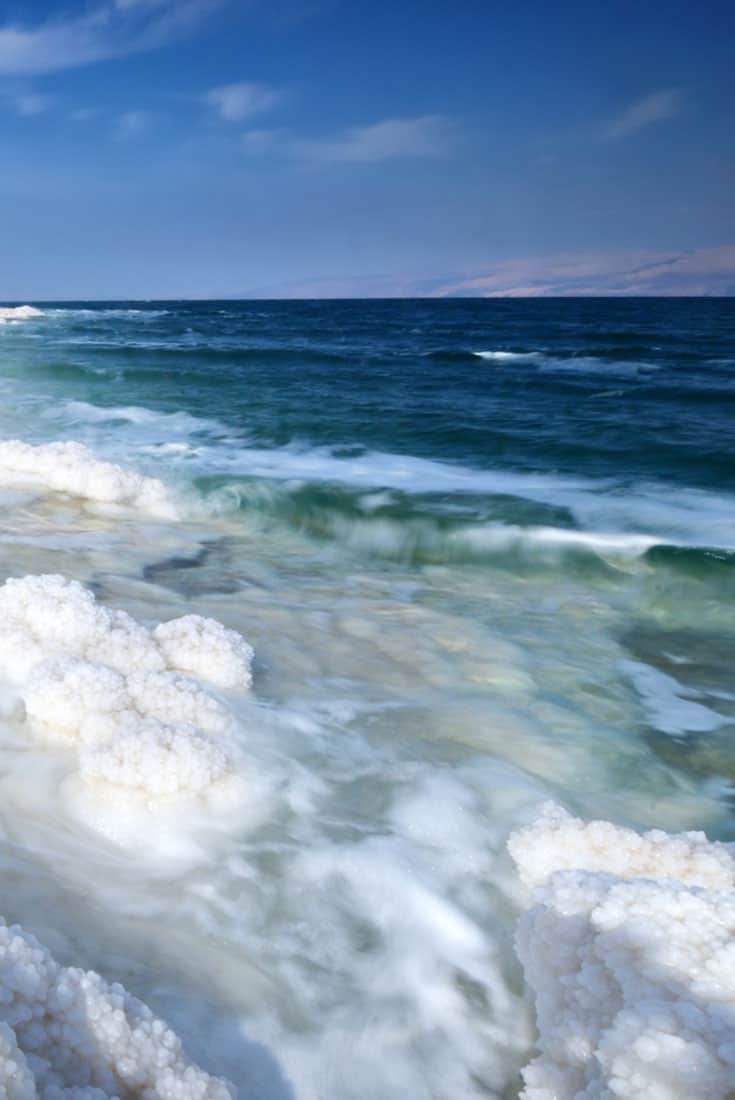
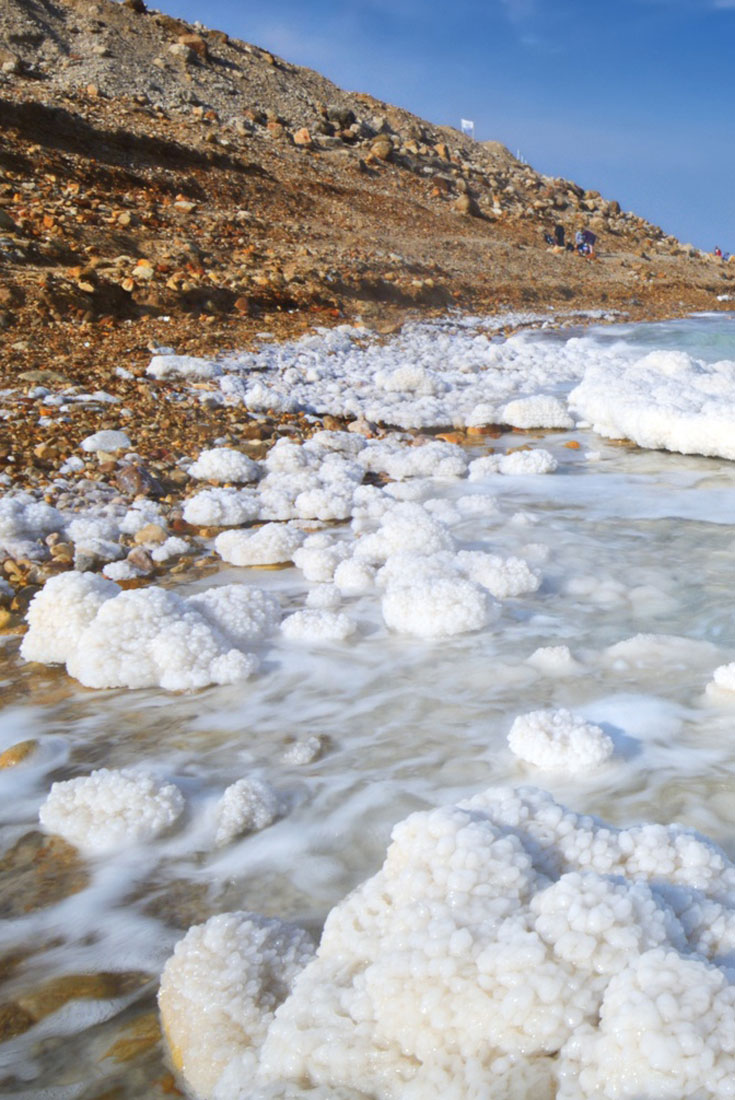
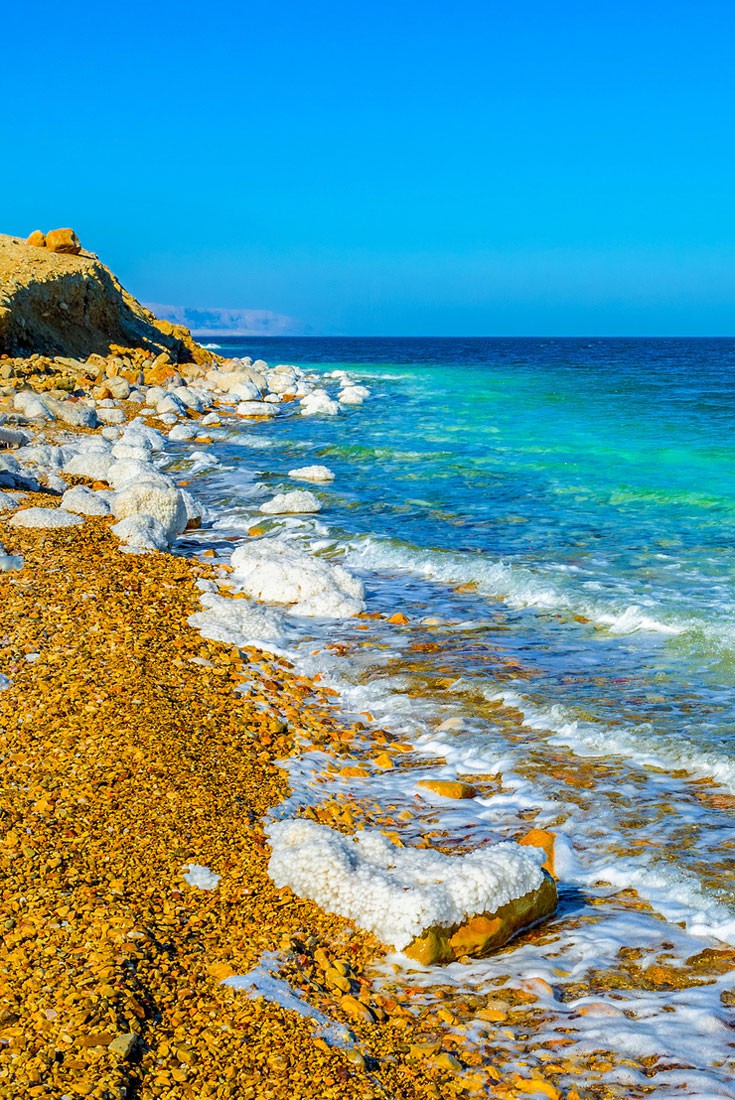
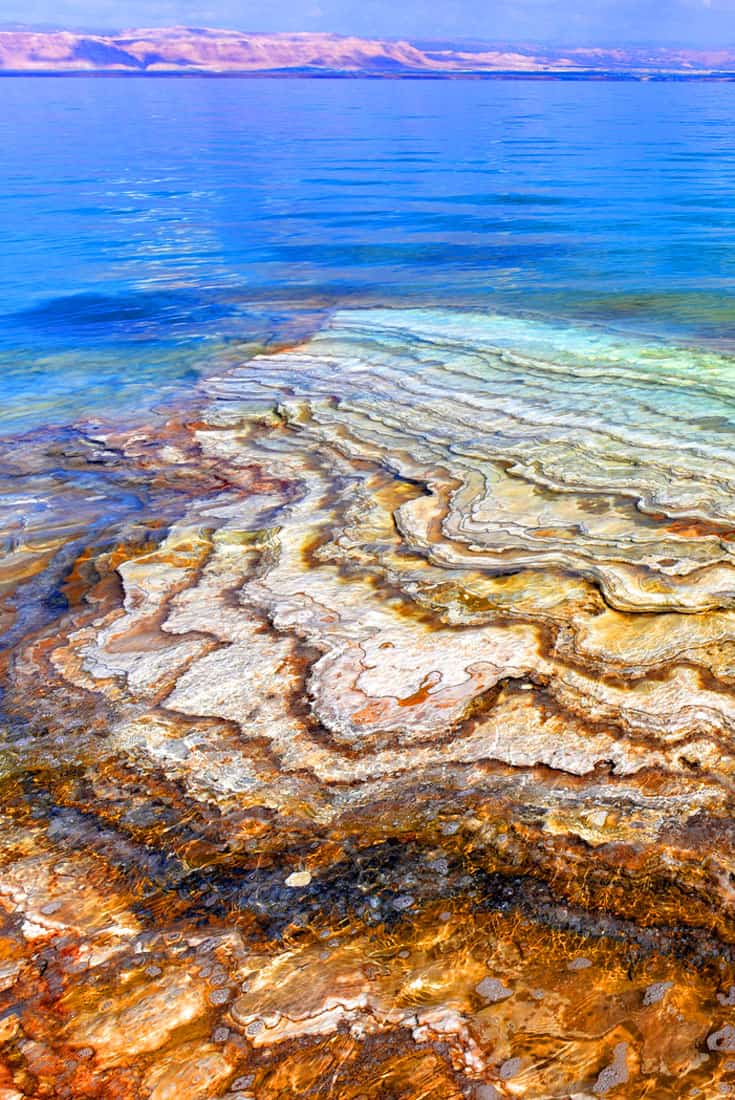
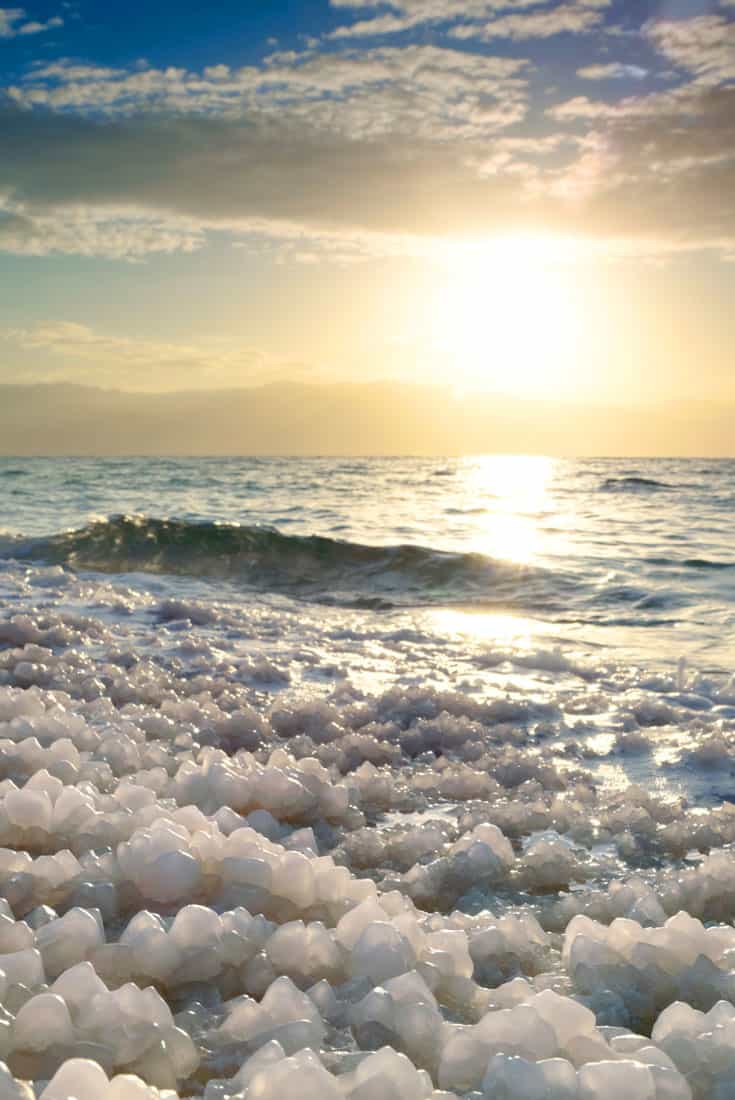
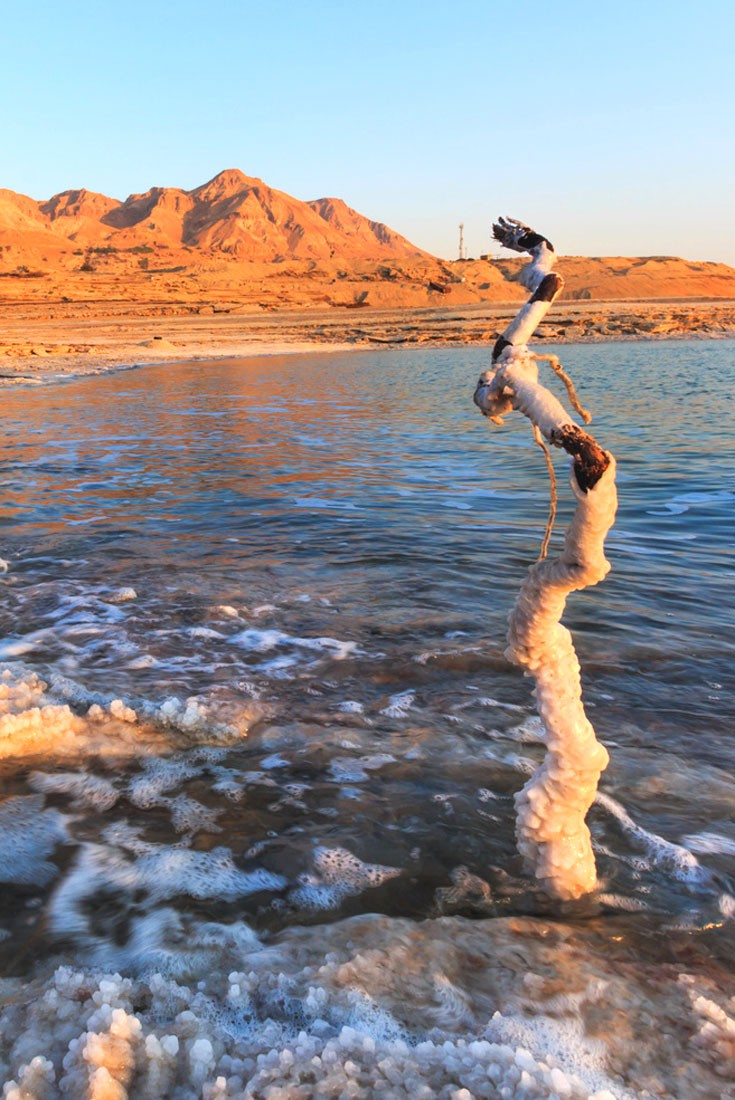
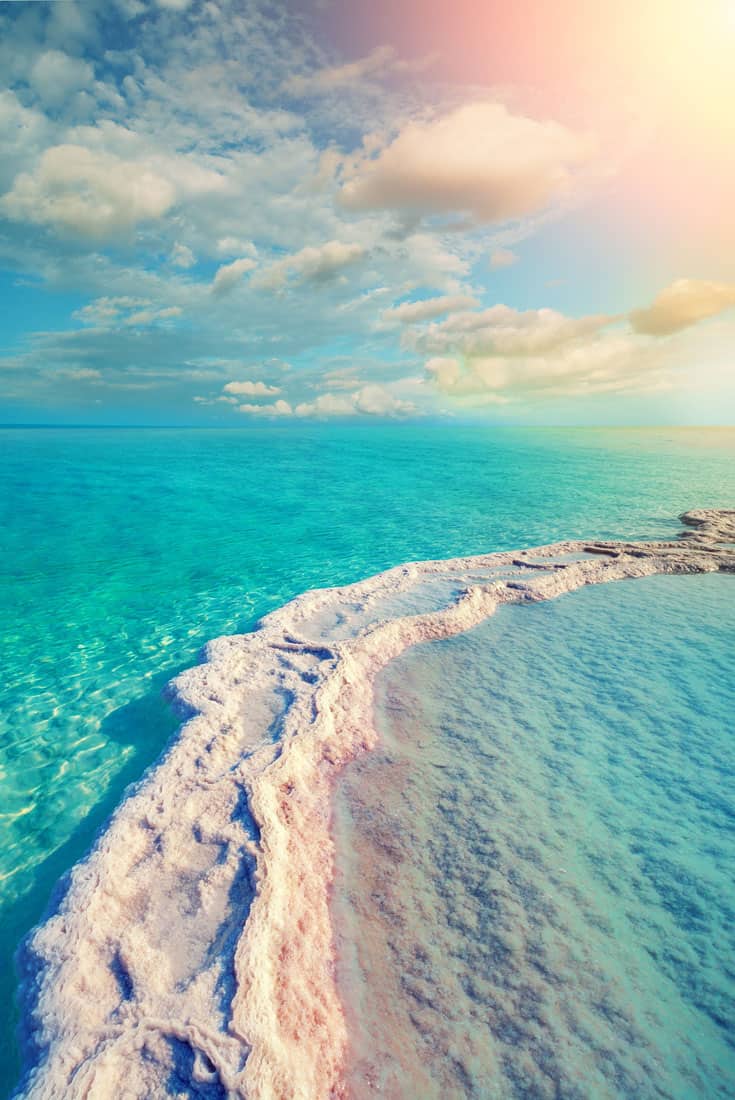
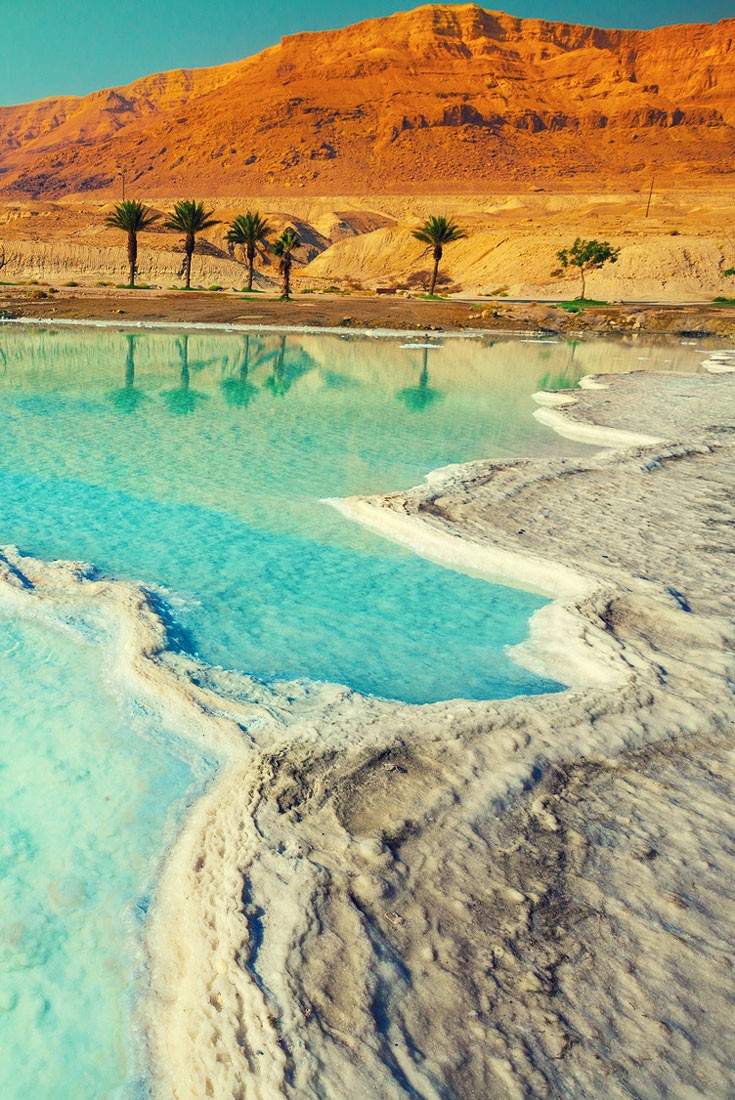
How about you? Have you ever visited the Dead Sea? Would you consider adding this experience to your Bucket List? Let me know in a comment!
Looking for more unique adventures in the Holy Land? Check out my other posts about traveling in Israel!
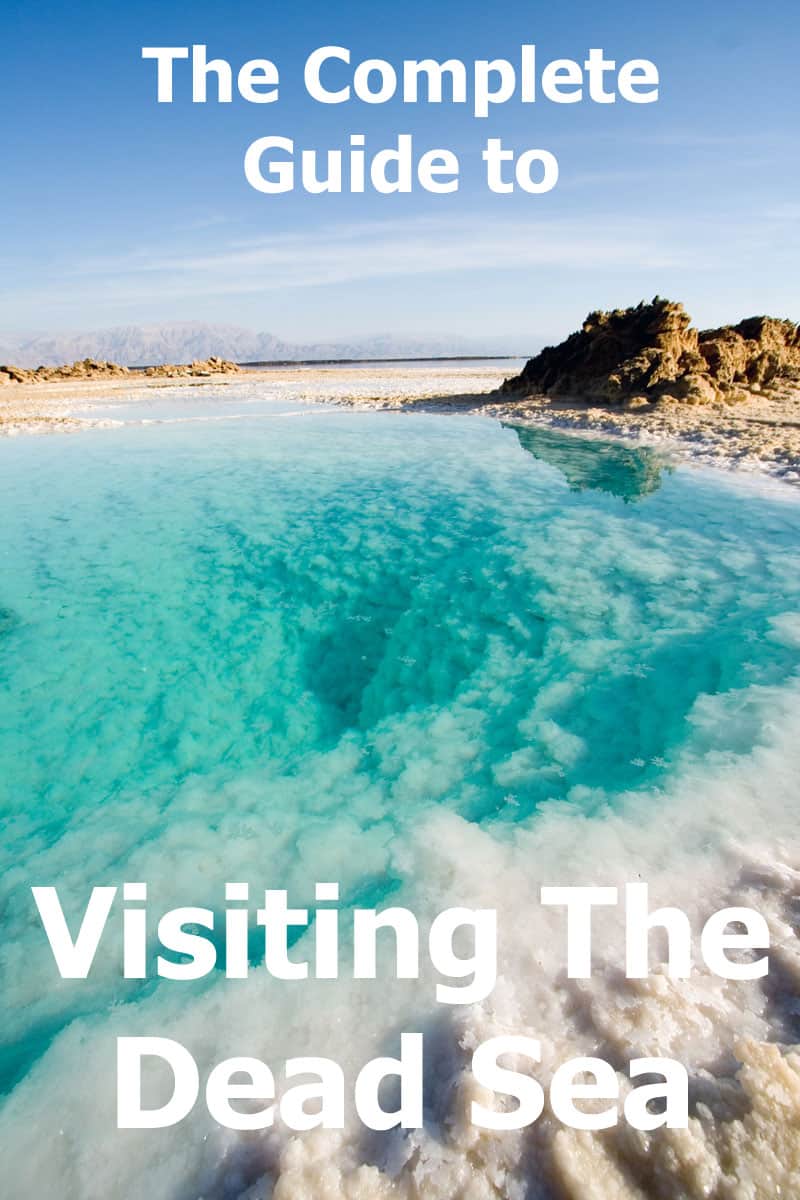

It means the world to us to hear such positive feedback on our blog posts. We strive to create valuable content for our readers and it’s always encouraging to hear that it’s making an impact.
I learned alot through your post, love our blog so much!
I am going next month, but is it safe for someone who has hemmoroids?
Hi Linda,
Good question. From Googling the question (in Hebrew) I’ve seen doctors that say that there may be a burning sensation when hemorrhoids are in contact with the saltwater of the Dead Sea. I guess a lot depends on the severity, location etc. Because these are such extreme conditions, with any medical condition, I would advise consulting with your physician about this.
Thanks so much for a super useful post! 🙂
Hi! Thanks for such a detailed post! Do you have any experiences with renting a car an driving to the dead sea via Jerusalem from Tel Aviv? Most rental car agreements mention that it is not allowed to drive into palestine area..
Sorry for the late reply, Lena! There’s a way to get to the Dead Sea that doesn’t take you through the Palestinian areas. If you use Google Maps for the route between Tel Aviv and Ein Bokek, that will take you through the town of Arad. This keeps you 100% within pre-67 lines, for sure, all the way to Kibbutz Ein Gedi (and beyond). Now, north of Ein Gedi, you’ll technically be entering post-67 areas which means this is “the territories”. However, there will be no roadblocks on your way because this area is inhabited by Israelis. If you try to keep going north to get back to Jerusalem, then you will encounter a roadblock as you enter Jerusalem.
I doubt the rental company will consider this Palestinian Territory either, but you never know with insurance companies (and this is down to insurance, in the end). I would either ask them directly in an email before heading out or just stick to the southern half of the Dead Sea, including Ein Gedi and Ein Bokek. This is also where Massada is and it’s generally the prettier area IMO anyway.
Thanks very much for the information which is very much helpful and i have two questions for you…..1) what are the benefits of dead sea? is it useful beyond skin issues, coz one of my friend’s doctor suggested her to visit to dead sea and see the difference as she is suffering from breast cancer (i feel sorry and sorrow to say this) 2) How is it different visiting Dead Sea in Jordan Compared to Israel , is it same or anything different? Thanks
Hi Suresh,
Sorry to hear about your friend! I never heard of any connection with cancer of any type. The only therapeutic value I’m aware of is for psoriasis patients. No idea about Jordan, I’m afraid. I’ve never crossed the border so I can’t really compare the two options.
Hi! Great post about visiting the Dead sea! I am going to visit Israel in November and I was wondering where did you stop by the Dead sea and where can be found those beautiful tourqisue lagoons?
Hi Spela,
The color of the water depends on the lighting and time of day. It can get that color in various places along the coast. The thing is, the coast isn’t accessible along most of the northern section because of sinkholes. So, the best bet of getting close to the water is by going to one of the beaches mentioned in the post. On a sunny day, you should be seeing the turquoise lagoons in any of them.
Hi Anne!
This was a great read. My family and I are visiting in October. I see a bunch of “tours” that cost quite a bit. But if we’re driving, do we need to worry about any “entry fee”? Or just parking?
Thanks again!
Mona
Hi Mona, I guess that would depend on the specific tour. I would expect them to cover all fees, maybe outside of meals. I’m not sure which tour allow you to drive your own car though. I would definitely contact them for all the details in advance, just to make sure.
Hi Anne,
Thank you very much for this article and honestly all of your website. I’m planning a trip to Israel in October, and I probably won’t rent a car. So I was wondering, if we have an overnight, what do you suggest? Let’s say one day a the beach, and with your recommandations, which one, and the other day, Ein Gedi or Massada? And if I don’t have time for an overnight, that I am in Jerusalem, but I want to swim in the sea and have a nice point of view, what do you recommend? (Accessible by bus)
Thank you very much again for all this informations. My trip will be absolutely awesome with all your tips !
Hi Sophie,
So glad you find this helpful!
If you’re staying in Jerusalem and just want to visit the Dead Sea for the day going on a bus, your best option is probably the northern beaches. There would be an entrance fee but it’s a shorter drive from Jerusalem so that you get more time there. As I just replied to another question, Biankini beach was just recommended to me by a friend who visited recently. It has all the facilities, including mud. According to their website (in Hebrew), it costs 80NIS on a weekday.
If you can stay overnight, I would go further south. If you you just want to enjoy the beach and combine this with a visit of Massada then the beaches of Ein Bokek should be your destination. I would start by checking these using the map options.
If at all possible, I would consider renting a car for a couple of days. It will allow you more flexibility and save you on waiting times for the bus. With a car, you could easily visit the beaches, the Ein Gedi streams (at least one hike) and Massada the following day. You can even overnight at the Massada campground and catch the night show there (check their website to see which days of the week it’s available).
Last but not least, October is holiday season in Israel, so check your dates carefully and plan accordingly. Everywhere is bound to be busier and more expensive. IF you’re not familiar with local holidays, check out this post. Good luck and enjoy your trip!
Thank you so much for your articles about Israel. We are going on a tour and your articles have been super helpful!
Thanks for taking the time to leave a comment, Ronna – I hope you have a wonderful time visiting Israel!
Hi Anne… planning on going in November . Where do we go for the mud bathe? Are showers available to rinse off
Hi Lois,
There are showers available at all beaches. It’s super important to have them to wash off the salty water, so you can count on showers and running water wherever there’s a proper beach.
For the mud, it’s hard to get by in recent years as some beaches were closed to the public because of the risk of sinkholes.
At this point, you have one of three options.
1. Go to any spa hotel there. They offer daily spa packages and they always offer large mud packets too.
2. Try the Biankini beach where they still have some traditional mud stands according (according to a friend who’s been there recently). There’s an entrance fee though of 80NIS on Sun-Wed and 100NIS on Thurs-Sat. I couldn’t find a website in English for the beach but it’s fairly well-known. It’s also the first beach coming from the north, so it’s a relatively short drive from Jerusalem. If using public transportation, ask the bus driver to drop you at Lido Junction or just tell him/her you’re going to Biankini beach. There’s about 10 minutes of walking time from the bus station to the beach.
3. Go to the Ein Bokek beaches mentioned in the post. They’re free and very well-maintained (and have showers). Go into one of the hotels there and purchase packets of muds and then apply them while at the beach.
I hope this helps!
Hi Anne,
Would you recommend wearing water shoes into the Dead Sea? In some photos, it looks like the shore is soft sand, but in other photos, I noticed it looks rocky. Thanks in advance!
Yolanda
Hi Yolanda,
Yes, some beaches are sandy and others are rocky. It’s interesting how that changes from one beach to another, isn’t it? It’s the same in the Sea of Galilee though the beaches of the Mediterranean in Israel are almost always sandy (thanks to the sand and silt coming from the Nile, of all places!)
I’m sensitive to rocks and stones in the water so I do use shoes. They can be water shoes or crocs or basically any footwear you feel comfortable with. And you may not need it at all, again, depending on the exact beach. Just remember to rinse the shoes thoroughly after use or they’ll turn white from all the salt in the water. Enjoy your trip to the Dead Sea!
Hi. Sorry but I forgot the other part of the question. We intend to hike from Metzoke Dragot to Ein Gedi and Hamei. What do you think? Is it a main road, a small road or a track? Thank you
Hello. We will hike the INT in october november but with a spin off to the dead sea and Masada. What can you tell me about the Dead Sea Coast Hike? Is there a map? No major problems? Thank you for an answer. Edouardo
Hi Edouardo,
As far as I can tell, the coast can be inaccessible in many points. What visitors usually do is go to certain beaches where the water is accessible. My guess is that’s why the INT doesn’t actually go through the Dead Sea. What’s more, there are some gorgeous slot canyons in the area that might be more rewarding for hikers (compared to just walking along the water/road. I found this map that suggests a route from the Dead Sea to Eilat. Most of it is the same as the INT but it adds the Dead Sea area. As you can see, they go through various canyons in the area, not just along the coast –
https://drive.google.com/file/d/0B_DXc1YJDxkHUGFHWkM1eDZXWnc/view
If you intend on hiking the entire way, I suggest contacting local hiking groups for more information. Not only is this a desert (so you need to know where to go, where you can get water etc) but there may also be military zones along the way. It’s not dangerous per se but you need to know where you’re going exactly. Local hikers can also help you with maps. To the best of my knowledge people use apps for that today (there’s cell phone reception almost everywhere).
I just noticed your other comment. Ein Gedi is great. Metzoke Dragot is beautiful but this is in fact in the West Bank, so again, you need to know where you’re coming from and where you’re going to. I’m thinking military fences and checkpoints here. I’m asking around for you about hiker groups that might be able to help you with more details.
Thanks so much!!!
Hi Anne, great information! Can you tell me if their are day trip tours from Jerusalemto the Dead Sea & Masada or am I better off renting a car as I would like to go to other locations in the area & Northern Israel. Any other suggestions you like to give I will very much appreciate. Thanks again!
Hi Kay,
I think either would be fine, really. Northern Israel and the Dead Sea would be hard to fit into one day. You can take one day for the Dead Sea and maybe part of the south by adding Makhtesh HaGadol. Here’s a possible route. That could work if you’re looking for a road trip without doing any hiking. If you want to incorporate hiking (and you should unless it’s summertime) then one day wouldn’t be enough for that.
So, you could rent a car for several days and then tour the northern parts (or southern) in depth. Alternatively, you could join a guided day tour or even just take the bus. You can use Google Maps to find out which buses will take you from Jerusalem to Ein Gedi and then to Ein Bokek. You could even stay the night in one of these kibbutzim or a bus back to Jerusalem. The bus drive would be about an hour and a half to two hours each way.
Thank you so much for this handy guide! We are amateur photography enthusiasts and were hoping to find the salt formations. Do you know where we can find them?
I’m glad you liked the post, Rachel!
There’s no easy answer as to where you can see the salt formations. Generally speaking, the further south you go, the better are your odds. The southern part of the Dead Sea is made up of shallower pools so you’re more likely to see salt formations coming out of the water. However, a lot depends on the water level and that changes not only by season but also by how much water the Dead Sea mineral plants decide to put into the lake. When they decide to harvest more minerals, they bring down the water level in the pools and you get to see more formations like the ones in the pictures. There’s also the question of accessibility. Some of the beaches are readily accessible, while others are not.
The road goes along the beaches, so your best bet is to stay by the southern part of the Dead Sea and then drive slowly along the coast, and keep an eye out for formations. Once you see something nice, pull over and evaluate accessibility according to your own level of fitness. If you’re lucky and the water level is low, you’ll probably get to see the formations at the hotels area (Ein Bokek). Good luck! If you come back with more tips, please do share them here!
Hey! Great article!!! Only one question, where are the two last pictures taken at exactly? It looks amazing and I am going there later on this month! Thx in advance!
Glad you like it! I am not the photographer but I believe they were taken just south of Ein Bokek beach. That’s where you have the shallow emerald pools with the salt ridges between them and that’s where Road 90 passes by the beach and has palm trees on the roadside (if you look carefully, you can see the road in the picture). Oh, and I didn’t take the photos without permission or anything, I bought them (just to clarify, I can’t stand it when people just grab photos from wherever on the net).
Enjoy your visit and do let me know if you have any more questions. I’ll do my best to answer them!
I have always wanted to go to Israel,The Dead Sea a must as I have psoriasis.I would work there if given the chance so I may stay and live there for a while..
Hi Tina. Yes, the Dead Sea would be wonderful for you. You may want to look into staying with one of the Kibbutzim there, as they may offer long-term stays that include use of the communal dining room.